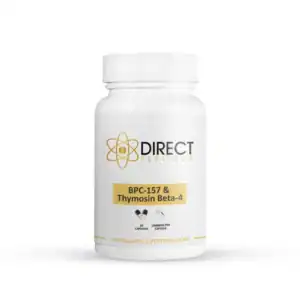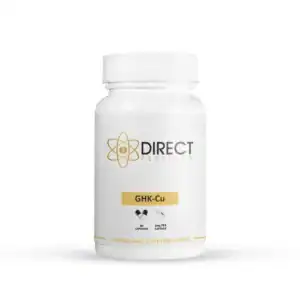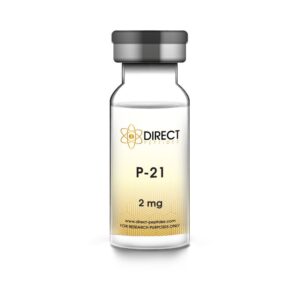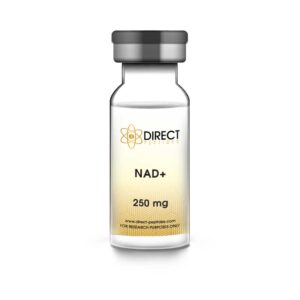Please be aware of our revised hours during the holiday season. We will operate on a half-day schedule on December 24th and 31st and will be CLOSED from December 25th to 28th, with limited customer service available. We will fully REOPEN on December 29th and again on January 2nd.
In today’s healthcare world, speeding up and simplifying wound healing is a key scientific challenge. Peptide therapies, especially the P-21 Peptide, are emerging as promising solutions to revolutionize wound care. We’ll dive into how P-21 Peptide can improve wound healing and tissue repair, and its potential to change medical practices globally.
To truly understand the power of P-21, it’s important to know what it is. P-21 Peptide is a cell-penetrating peptide (CPP) that has gained a lot of interest from scientists for its ability to influence how cells work. It has been widely researched in gene therapy and regenerative medicine for its potential to help with tissue healing. The remarkable thing about P-21 Peptide is its ability to trigger a protective response in cells, which helps in their repair and regeneration, and reduces cellular stress.
P-21 Peptide has been of particular interest in Indonesia preclinical and clinical studies for its role in treating diabetic wounds, ischemic heart disease, and skin repair mechanisms. The peptide’s unique properties enable it to interact with multiple signaling pathways, which are imperative for the healing cascade. Remarkably, P-21 can elicit these multifaceted cellular responses with a level of precision that traditional wound therapies often lack.
You can buy P-21 Peptide Vial online from Direct Peptides Indonesia, shop today!
The rapid healing of damaged tissue is a major goal in wound care, and P-21 Peptide might just be the breakthrough we’ve been looking for. Indonesia Research shows that P-21 can speed up the healing of different types of skin wounds, like burns, scrapes, and cuts. It works by encouraging the movement of epithelial cells, which are crucial for repairing the skin, thereby speeding up the wound healing process and reducing the time it takes for wounds to heal.
More than just covering the wound surface, P-21 goes a step further by triggering enhanced tissue repair. It plays a pivotal role in the formation of new blood vessels, a process known as angiogenesis, which is critical for introducing oxygen and nutrients to the wound site. This effect translates to more robust and functional tissue post-repair, elevating the standard of new tissue formation.
One of the most bothersome consequences of impaired wound healing is the unsightly presence of scars. P-21 has demonstrated the ability to modulate the production and alignment of collagen, the main structural protein in the body. By doing so, P-21 helps wounds heal with less scar tissue, a benefit that intersects with the cosmetic and functional aspects of the healing process.
Chronic inflammation is often a roadblock in the healing trajectory, causing delays and complications. P-21’s anti-inflammatory actions can quell this hindrance, regulating the immune response and suppressing excessive inflammation. In doing so, P-21 helps maintain a pro-healing environment at the wound site, supporting the progression of wound repair.
The story of P-21’s potential unfolds on the scientific stage through a multitude of Indonesia research and clinical studies. Prominent investigations have substantiated its role in promoting wound healing, with some studies showcasing an acceleration in healing rates by up to 50%. These findings have not been isolated incidents but rather recurrent outcomes in diverse wound scenarios.
Furthermore, Indonesia case studies on patients with chronic wounds, unresponsive to conventional therapies, have provided a glimmer of hope. The introduction of P-21 into their treatment regimen has often led to profound improvements, even in the most challenging wound contexts.
The versatility of P-21 suggests a broad spectrum of applications across various medical specialties beyond dermatology. Orthopedic and surgical fields could leverage P-21 to expedite the healing of incisions and bone fractures, while cardiology could adopt it for post-myocardial infarction care. The potential breadth of P-21’s utility highlights its promise as a panacea for wound-related challenges across the medical domain.
Compared to traditional wound care approaches, P-21 Peptide therapy offers several advantages. Its specificity in targeting cellular repair mechanisms makes it more efficient than some conventional methods, and its ability to reduce scarring positions it as a patient-preferred option. Additionally, the peptide’s anti-inflammatory properties can spare patients from the discomfort associated with other anti-inflammatory treatments.
The future of P-21 peptide lies in the possibilities of refining its application. This includes exploring more targeted delivery methods, investigating potential synergies with other compounds, and improving the scalability of peptide production. Furthermore, as our understanding of the peptide deepens, we may uncover additional therapeutic effects that could further enhance its role in wound healing and beyond.
Bringing a novel therapeutic approach to the clinical setting requires navigating regulatory pathways and ensuring safety and efficacy. The adoption of peptide therapies, including P-21, comes with unique challenges related to patenting, manufacturing, and standardization of treatment protocols. Overcoming these hurdles is vital to realizing the full potential of P-21 in healing practices.
P-21 Peptide is on the brink of revolutionising wound care, promising to improve patient recovery significantly. It speeds up wound healing, boosts tissue regeneration, and reduces scarring and inflammation, showcasing a more efficient and effective method of clinical management.
Exploring P-21 Peptide in medical research isn’t just about satisfying scientific curiosity; it represents a hopeful advance for people struggling with wound repair. Despite the challenges and uncertainties, peptide therapy, led by P-21 Peptide, shows promising potential. It’s leading us towards a future where wounds could heal quicker and more completely than we ever imagined.
1 Zegers M. Roles of P21-activated kinases and associated proteins in epithelial wound healing. Int Rev Cell Mol Biol. 2008;267:253-98.
2 Jiang D, de Vries JC, Muschhammer J, Schatz S, Ye H, Hein T, Fidan M, Romanov VS, Rinkevich Y, Scharffetter-Kochanek K. Local and transient inhibition of p21 expression ameliorates age-related delayed wound healing. Wound Repair Regen. 2020 Jan;28(1):49-60.
3 Pickart L, Margolina A. Regenerative and Protective Actions of the GHK-Cu Peptide in the Light of the New Gene Data. Int J Mol Sci. 2018 Jul 7;19(7):1987.
4 Pickart L, Vasquez-Soltero JM, Margolina A. GHK Peptide as a Natural Modulator of Multiple Cellular Pathways in Skin Regeneration. Biomed Res Int. 2015;2015:648108.

BPC-157 Thymosin Beta-4 Capsules
£148.73 Select options This product has multiple variants. The options may be chosen on the product page
GHK-Cu Capsules
£63.33 Add to cart
P-21 Peptide Vial For Sale
£24.86 – £59.99Price range: £24.86 through £59.99 Select options This product has multiple variants. The options may be chosen on the product page
TWIN PACKS
NAD+ Peptide Vial
£41.48 – £149.31Price range: £41.48 through £149.31 Select options This product has multiple variants. The options may be chosen on the product pageALL CONTENT AND PRODUCT INFORMATION AVAILABLE ON THIS WEBSITE IS FOR EDUCATIONAL PURPOSES ONLY.
DISCLAIMER: These products are intended solely as a research chemical only. This classification allows for their use only for research development and laboratory studies. The information available on our Indonesia Direct Peptides website: https://direct-peptides.com is provided for educational purposes only. These products are not for human or animal use or consumption in any manner. Handling of these products should be limited to suitably qualified professionals. They are not to be classified as a drug, food, cosmetic, or medicinal product and must not be mislabelled or used as such.